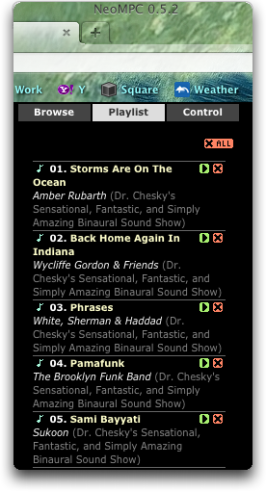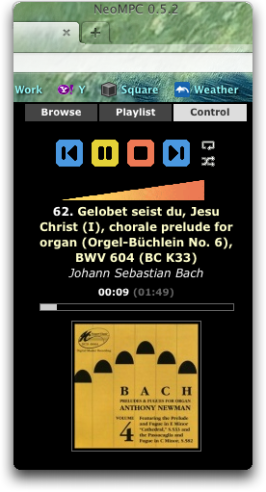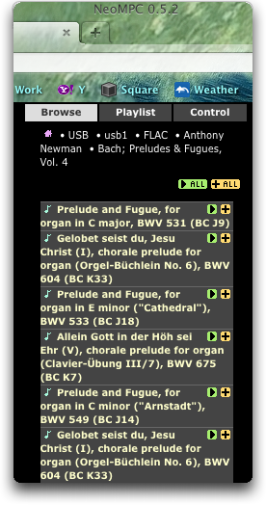This is not a knock on Fujitsu, my ScanSnap is close to 10 years old; and that is longer than most vendors support old hardware. In any event, other than some minor damage to the multi-sheet tray/base of the scanner, the ScanSnap is still chugging along. I've kept an old Mac around just to scan documents as my scanner lost support starting with with OS X Mountain Lion (10.8). No more! To this point, I've not complaints with VueScan. Time will tell if the unlimited upgrades for the "Pro" version are meaningful.

Canon 5D Mk II. EF 17-40mm f/4L USM at ISO 100, 26mm, f/4, 1/350. Cropped and converted to PNG using the simplest of tools - iPhoto.
[A version of this post (July 23, 2012) has been deleted from my gaming blog. It never belonged there, but was placed there at a time when Posterous was having issues. Updating the post, and placing it here seems only fitting.]
A free iPhone/iPod Touch app - MPoD - controls the MPD service on the Auraliti PK 100 (there is a premium version of MPoD for the iPad, MPaD, that sells for $2.99/ €2.39). The good news with the PK 100 is that, if you use the right MPD client, you don't need to know anything about MPD - so don't be intimidated by MPD! There is a client for MPD on just about any mainstream computing platform, but I'm partial to MPoD and MPaD. An important concept to grasp is that multiple MPD clients can control MPD at the same time, and the view of the Playlist dynamically updates across all clients.
In many instances, one has to know the IP address of the machine(s) running MPD; but the Auraliti PK 100 will usually be auto-discovered by MPoD and MPaD (assuming your iOS device's wifi connection can "see" the network the PK 100 is connected to). Here is how a PK 100 looks in MPoD:

Once you have connected to MPD, it will update your client's copy of the MPD database and start caching album art. This can take a few minutes for the former and much longer for the latter. In any event, here is MPoD's main menu:

As you can see, you have several ways of selecting music for playback. I'll cover each of the selection options, but will start with the most useful option for me - Browse. This is the option that allows one to directly access the folders where one has saved one's music. From this view one can select albums or tracks directly from attached USB (and some NAS) devices; and it is particularly handy if one's metadata is less than perfect or if one just prefers to view a music collection via the folder hierarchy on a storage device. I put a great deal of care into the folders where I store my music. Thus, this is the most useful way of finding what I want to play, but this may not be the case if you put your effort into tagging your music collection. In any event, here is a shot of the Browse view in MPoD (there is no search feature here):

This is the Artist view in MPoD (by pulling down on the screen, one can search in this view):

This is the Album view in MPoD (search is availble in this view):

And this is the Genre view in MPoD (no search feature here):

I skipped the Song view as it is only good for searching for a single song title in my opinion. In any event, from the Album, Artist, Genre and Browse screens one can select an album to play (or a group of albums depending on organization). As soon a you select an album for playback, it is automatically placed in the Playlist (the active queue of songs that may be played); and the song at the top of the Playlist will start playing. In MPoD, it looks like this:

MPaD works much the same way as MPoD, but is a little more streamlined due to the extra screen real estate:

As you can see, your Playlist is on the left side of the screen, and you can choose from all the selection views MPoD offered as well as selecting music from last.fm. The Info view adds a handy integrated web browser on the right side of the screen. For completeness, I'll provide screen shots of the selection views available in MPaD at the end of this post. This is probably a good time to talk about some of the weaknesses of MPD and/or MPoD/MPaD.
The greatest weakness of MPoD and MPaD is the limited space for text in any of the selection views. This might not be as big a deal as it is were album cover art always available and always correct, but this is not the case.
The Album, Artist and Genre selection views are going to be of greatest use if you have been scrupulously consistent with tagging your music collection. The less true this is, the less useful these selection views are. In my case, the tags for flac, ogg and mp3 files are not well maintained as I did that sort of thing in iTunes. In addition, I've not found an MPD client that offers anything like iTunes' Smart Playlists. Thus, I tend to look things up in iTunes if I want to browse a tagged music list; and then search for the album or artist in MPoD or MPaD.
The Playlist can be treacherous. The currently selected song in the Playlist is the insertion point for any songs or albums that you want to add to the Playlist. If the last song in the Playlist is selected, then new songs or albums are appended to the Playlist as one might expect:

However, if you want to add to the Playlist when the song that is playing is not the last song in the Playlist, you get this:


Another annoyance with MPoD and MPaD is album cover art. MPoD seems to be limited to the cover art saved in the album's file folder as an image file (commonly "Folder.jpg"). MPaD has a Cover Wizard button:


Even with the aforementioned MPoD/MPaD deficiencies, the Auraliti PK 100 is still my favorite digital file player . . . it is transparent with no background noise that I can hear when paired with a good DAC (Schiit Gungnir in my case). YMMV of course, but I really like the PK 100. MPoD is fine as it is free, and it does everything necessary to play music on the PK 100. MPaD . . . that is a tougher call. I recommend skipping it if spending $3 is something that you have to think twice about before hitting the "buy" button.
If the Auraliti PK 100 is too rich for your blood and you don't mind some light editing of configuration files, you may be able to duplicate the magic with GMPC (Gnome Music Player Client) or Ario with MPD on Audiophile Linux and a "quiet" PC build of your own. This will probably be the topic of my next post on the big blog.
As promised, here are more screenshots of MPaD. The Album view:


The Genre view:

Fixing the Playlist with the MPaD:

[Originally posted to my gaming blog on July 21, 2012 . . . when Posterous was having issues. Moving the post here to clean things up at the gaming blog. Also, there will be a related post here that touches on the topics of MPD and MPD clients in a few days . . . or a few weeks! ;) ]
What? A post about something other than gaming? Well . . . Posterous is on the fritz a lot of late; and I may just start posting some of the more random stuff here instead of hassling with the fail over there.
The Auraliti PK 100 is advertised as an audiophile grade music player. It has no storage of its own, you can hook up to 3 or 4 USB drives on the one I have. The PK 100 is a small fanless PC that decodes FLAC, WAV, AIFF and MP3 files (the latter not mentioned in the docs, but claimed to work by one reviewer - will test later). It then either processes the digital audio stream itself using its built-in DAC (outputs analog stereo via standard RCA) or sends the stream to an external DAC of your choosing via S/PDIF (it has a BNC connector for this). All of these functions work great.
The PK 100 must be controlled over your local network (and thus must be connected to it) via your PC, Mac, iOS or Android devices. The folks at Auraliti recommend getting started with the NeoMPC web app. Here is a screen shot of the Browser screen where you can select tracks to add to the device's play list [in NeoMPC]:
And here is a shot of the playlist screen:
And finally here are the basic but "good enough" playback controls:

So far . . . and it is still early days . . . I'm liking this device.
[August 31, 2014: two years on and I am still using the PK 100. I have nothing bad to say about it. I did buy the linear power supply to deal with locations where AC is not so clean, but try it with the wall wart first!]
The conversation regarding the utility of objective measurements and audio quality continues . . . with the seductive siren call of quantitative "certainty" gaining more traction. Certainly the research by Harman International's Sean Olive is a huge step forward, and is worth a look if you are interested in the topic or are thinking of trying to upgrade your headphones.
What is most interesting, at least to me, is how well measurements can reinforce subjective opinion and/or experience. A recent reddit post by SanjiWatsuki discusses some measurements of many of today's top headphones. SanjiWatsuki's report is interesting because the measurements seem to track fairly well with the headphones that are most often mentioned as top performers on Head-Fi.org. As is now common, I find Tyll Hertsens' comments a useful reality check.
Less test shots and more trying to learn how to use this lens for landscape and nature photography (not really the strengths for this lens). Anyhow, here goes . . . my favorite shots from an early fall morning around Lake Sabrina (Inyo National Forest above Bishop, California).




And a few more from the same area, this time by South Lake.




Another sale at HDtracks. This time it is a decent mix of live recordings - many in high resolution. Interesting, but no guarantee of quality I'm afraid. Still, if there are some holes in your music collection (as there certainly are in mine!), don't say I didn't try to let you know.
The standouts for me are:
- Peter Frampton's Frampton Comes Alive!
- The Kinks' One for the Road
- Keith Jarrett's The Koln Concert
- The Band's The Last Waltz
- The San Francisco Symphony's American Mavericks (Michael Tilson Thomas conducting)
Those that know me are all too well aware of my weakness for both headphones and surround sound audio. To this point, I have only been able to enjoy them separately. This is not because the technology doesn't exist to combine the two, but because it has not been done at a price that is reasonable to me and/or at reasonable quality. For purposes of gaming, there are several serviceable options; but none of them are even remotely audiophile caliber.
The current state-of-the-art for surround sound processing for headphones is the Smyth Realiser A8. Not only is the Realiser highly regarded, but it is still unique in responding to even fairly modest movements of your head as you listen - something we do naturally to pinpoint the source of a sound. No matter how attractive the Realiser is, it is too rich for my blood at $3,000.
However, we may be able to get quality affordable headphone surround sound from DTS in the near future in the form of DTS' Headphone:X. The element that they are doing "right" is compensating for headphone characteristics, but it is going to take them time to build a library of measurements for all the headphones that are available. On the basis of what I think I heard on a recent Home Theater Geeks podcast, DTS is not prioritizing even mid-fi headphones like the Sennheiser HD-600 or HD-650 when it comes to getting measurements. Thus, it may take awhile for Headphone:X to work with any of my favored headphones. Equally discouraging, is that DTS is licensing the technology to OEMs; and who knows what quality of gear is going to include Headphone:X in it. From what I heard in the podcast, at least in the near term, none of the gear is going to appeal to audiophiles.
So. It looks like concerts on blu-ray will remain a non-headphone experience for some time to come. Still. At least there is hope that we are not a decade away from seeing a competent pairing of surround sound to headphones in a manner that is satisfying for more than just gaming.
Just took delivery of a Sigma 85mm f/1.4 lens, and tried it with a Canon EOS 5D Mark II. I bought the lens for shooting indoor family events, taking portraits and maybe some still life shots. The attraction was a little reach with decent low light performance, and this seems to be a win. We'll see. Reviews rightly point out some problems with relatively slow auto-focus (so this is not a great lens for indoor sporting events), and the edges of the image are not terribly sharp when shooting wide open. That said, it is fairly easy to compose and shoot around these limitations with relatively static scenes.
Obviously, the depth of field is going to be very shallow when shooting wide open; and that is what these test shots are going to illustrate. Since I mostly shoot landscapes, I haven't played around with shallow depth of field much - particularly as I haven't had access to a lens that lends itself to this before.
The three images that follow were shot from about four feet away and are of some old hard drives. The center drive is about an inch forward of the right drive, and the left drive is about another inch further still into the background from the right drive (or about two inches from the front of the center drive). First, a shot focusing on the center drive:

The particulars: ISO 400, f/1.4, 1/125 sec. For the next shot, the focus is on the right drive:

The settings were ISO 400, f/1.4, 1/250. The last shot of this series was focused on the left drive:

The settings were ISO 400, f/1.4, 1/250.

The settings were ISO 400, f/1.4, 1/750; and the shot was from around 3.5 feet.
The final two shots are of some coins; again taken from about 4 feet away. A quarter is resting on the lens cap, and the machine screws are in the top right of each image. I do like the blur one can achieve for objects that are not the subject of the shot (i.e. the machine screws). The shots demonstrate how the depth of field changes with even a modest change in f-stop.

The settings were ISO 400, f/1.4, 1/250.

The settings were ISO 400, f/2.8, 1/60.
I think I am going to have a lot of fun with this lens.

Just a shot that I also shared to flickr. I wish for more ways to share to/from here. Maybe in time.
